
 |
Opijnen Memorial, Holland
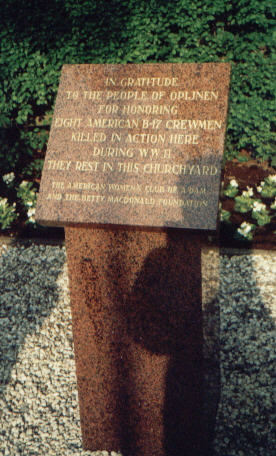
IN GRATITUDE
TO THE PEOPLE OF OPIJNEN
FOR HONORING EIGHT AMERICAN B-17 CREWMEN KILLED IN ACTION HERE DURING WORLD WAR II. THEY REST IN THIS CHURCHYARD.
THE AMERICAN WOMEN'S CLUB OF AMSTERDAM AND THE BETTY McDONALD FOUNDATION
The Plane was Man-O-War 41-24399. Crew members Buried in Opijnen:
1st Lt. Robert U. Duggan, Navigator
2nd Lt. Daniel V. Ohman, Bombardier
T/Sgt. Douglas V. Blackwood, Radioman
T/Sgt. Americo Cianfichi, Engineer
S/Sgt. Mike A. Perrotta, Ball Turret
S/Sgt. Harold R. Sparks, Waist Gunner
S/Sgt. George R. Krueger, Waist Gunner
S/Sgt. Hermon d. Poling, Tail Gunner
American War Memorials Overseas website
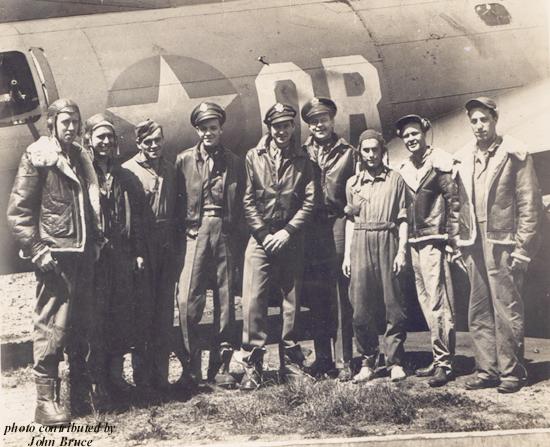
Serial # 41-24399
Standing - Left to Right:
S/Sgt. Hermon D. Poling, Tail Gunner; S/Sgt. Harold R. Sparks, Waist Gunner; S/Sgt. George R. Krueger, Waist Gunner; 2nd Lt. John P. Bruce, Co-pilot; 2nd. Lt. Keene C. McCammon, Pilot; 2nd Lt. Daniel V. Ohman, Bombardier; S/Sgt. Mike A. Perrotta, Ball Turret Gunner; T/Sgt. Douglas V. Blackwood, Radio Operator; T/Sgt. Americo Cianfichi, Engineer. Not pictured, 1st Lt. Robert U. Duggan, Navigator.
Man O War Factoid - The original navigator, Gill, was replaced by 1st Lt. Robert U. Duggan (neither of which is shown in this photo). Gill was not in this photo as he was KIA with Forsblad's crew aboard the plane named Stricnine, just 10 days before this crew was shot down on July 30, 1943. Only McCammon and Bruce survived.
(Article from 30 May 1970 Memorial Day Ceremonies at Est en Opijnen, The Netherlands (The unknown writer was probably on the staff of the base newspaper of Camp New Amsterdam Air Base, home of the U.S. Air Force 32nd Tactical Fighter Squadron, tenant on the Royal Netherlands Air Base at tSoesterberg, The Netherlands, approximately 20 miles north of the Dutch village of Opijnen, pronounced "o-PIE-nen")
Dutch Village Pays Tribute
WAR DEAD REMEMBERED
Soesterberg AB, The Netherlands--Peace and serenity reigned over the community
of Opijnen, The Netherlands, on a bright sunny July 30th, 1943. The ravages of
World War II had not yet reached this small farming village. Local farmers were
in the fields harvesting their crops and preparing to
take a short lunch break when a totally unexpected noise broke the stillness.
Overhead, a limping American B-17 bomber was being attacked by fighter aircraft
of the German Luftwaffe. The lumbering giant didn't stand a chance against the
swifter, more maneuverable fighters.
The farmers stopped their work and stared in awe as the crew members bailed out
of their burning craft, hopefully to safety.
Their hope was short lived, however, because as the crew descended, the German
aircraft banked sharply and strafed the crew as they dangled helpless in their
parachutes.
Hendrick de Kock, one of the Opijnen farmers in the fields that day, recalled,
"Eight of the crew members got out of the airplane, but when they were
hanging on those big umbrellas the German fighter started shooting at those poor
boys. Oh, man, I got so mad I could have killed that
fellow in the fighter."
From a crew of ten, two died in the aircraft, six died as a result of the
strafing, and the other two were captured by German ground forces.
One of the men fell through the roof of a farm house adjacent to the field and
lived long enough for de Kock to get him a drink of water--an extraordinarily
brave act as the German ground forces were shooting at the local Dutchmen as
well as at the Americans.
De Kock recalled, "He fell through the thatched roof and struck his head on
one of the main beams of the house. I got him a drink of water, he gave me a few
cigarettes to thank me, and then he died."
Two members of the crew survived but they were captured almost immediately by
the Nazis.
The few facts that are known about the bomber indicate that it was from the 91st
Bomb Group (now the 91st Bomb Wing, SAC), Eighth Army Air Force, flying from an
air base in England on a mission to Kassel, Germany. The townspeople of the
village carried the bodies of the dead airmen to their local cemetery and kept the bodies in a small building until the Germans
granted them burial permission. After permission came from Berlin the graves
were marked with simple wooden crosses inscribed only with the men's names.
At the end of the war, the remains of American servicemen buried on foreign soil
were removed to central military cemeteries. However, the citizens of Opijnen
requested that the graves of the eight airmen be left to their care in their own
village cemetery.
The thought behind this small plot of land where these airmen are buried is best
described by the citizens of Opijnen: "Where would we be and how would we
live if it had not been for our Allies who fought and died for our freedom? In
these eight men resting here in Opijnen under these marble headstones, we honor all men, that on this day we can be here having memorial
services and speak our mind in freedom."
The eight graves are now marked with white marble headstones and are provided
tender care by both the adults and children of the village.
In this article there is a badly smudged photograph of Mr. De Kock with a
caption that reads: "On that day in 1943, Hendrick de Kock, an Opijnen
farmer, was working in his father's hay fields when the B-17 was shot down. At
risk of his own life, he attempted to help the dying American fliers."
AMERICAN WOMEN’S CLUB OF AMSTERDAM
September 2007 Tulip Talk Article
“In Memoriam – John Bruce”
by
Nancy L. Koster-Tschirhart
Will the circle be unbroken? Bye and bye, Lord. Bye and bye. Will our crew be back together? In the sky, Lord. In the sky.” Paraphrasing the A. P. Carter hit, “Will the Circle Be Unbroken”, Mike Banta of the 91st Bomb Group Memorial Association concluded his e-mail about fellow “Ring” airman, John Bruce, rejoining his crew on August 1, 2007 at the age of 87 years.
For AWCA members who’ve been here in May, you will know about this most courageous, honorable, gentle and inspiring hero, John Bruce. John Bruce and pilot, Keene McCammon, were the only survivors when their plane was strafed over Holland by Nazi’s as they returned to England from their first—and only—combat mission, successfully taking out a munitions factory in Kassel, Germany. On that horrifying day, July 30, 1943, their U.S. 8th Air Force, 1st Air Division, 323rd Squadron, B-17 bomber, Man-O-War, was hobbling back, desperately hoping to cross the North Sea and return to safety. That was not to be their fate. While John and Keene parachuted to safety, to be betrayed by Nazi sympathizers and imprisoned in German stalags until World War II ended in 1945, their eight crewmen were shot as they drifted down over the fields near the Waal River. While the Nazi’s at first refused to let the Dutch villagers care for the dead airmen, they ultimately let the men be buried in the dark of night to prevent any show of sympathy from the Opijnen people. (To counter this, the morning light revealed that the crudely dug graves had been covered with flowers!) After the war, at the request of the villagers, the eight men came to rest in the churchyard cemetery in the village of Opijnen instead of being reburied at the American cemetery in Margraten. Every May since 1949, the American Women’s Club of Amsterdam has commemorated the sacrifices these men made and have honored not only them, but the brave and devoted villagers who have cared for our fellow Americans since 1943. (Read more at www.awca.nl and click on History/Opijnen.)
With that history in mind, we move to the year 2000. That’s when I was privileged to become acquainted with John and Keene, who had not been in contact with the AWCA since unveiling the Opijnen churchyard monument in 1983. As AWCA President preparing for the bi-decadienal Opijnen memorial service, I had the opportunity to read letters from both men to the guests gathered in the church at Opijnen. And from there, friendships grew, sparked by big ideas from them and former Neerijnen (community of 11 villages, including Opijnen) mayor, Ton Jansen. At the 2000 service, Mayor Jansen spoke of his dream to name streets for the eight airmen in a planned housing development so future generations would know this story of bravery. When the plans became firm in 2002, I informed John and Keene, and with their wives, they offered to donate money to show their gratitude to Opijnen (as did the AWCA). Mayor Jansen proposed that a monument be built to explain why all the streets have non-Dutch names. I had the honor of participating in the planning session to name the streets, and while there were technically just four streets, we not only managed to subdivide them into eights streets, but at my request, Brucestraat and McCammonplein were also incorporated. Sadly, Keene McCammon passed away October 2003 and could not join John and Mayor Jansen when they unveiled the street signs May 4, 2004. And, even though John’s beloved wife Eunice passed away April 4, 2006, John (with his foot in a cast) and his children returned to Opijnen. They were joined by Keene’s widow, Bonney Jean, and son, Keene, and Keene’s sister, Eloise, and her daughter, Lois, to unveil the impressive monument on McCammonplein. With a Marine Honor Guard in attendance, 35,000 bricks depicting the shadow of a B-17 flying overhead, and the raised monument replicating the plane’s stabilizer (with inscriptions in Dutch and English) were unveiled. The two U.S. flags that covered the stabilizer had flown over the U.S. Capitol and were presented to John and Bonney Jean. For those who attended these ceremonies in 2004 and 2006, the real meanings of patriotism, courage, sacrifice and peace burn more brightly, memories engraved forever. As John so often said, “Freedom is not free.”
And this is the man I want to memorialize. As past U.S. Consul General and AWCA Honorary President (2003-2006), Michele Thoren Bond, reflected in her response to John’s passing, “What a good man he was, so kind and gentle and modest. I will never forget his voice and his words on the bus tour during his last visit to Opijnen, when we were stopped at the spot where his parachute came down, and he described the crash and its aftermath. Though he spoke softly, the images he evoked were so indelible and vivid it seemed the rest of us were taken back with him to that terrible period of Nazi occupation. He was truly an outstanding example of the Greatest Generation.”
For me, John was the kind of friend who comes along once in a lifetime. I still have his first e-mail: an AWCA website feedback form from March 2000 to which I responded. And now, as Opijnen Memorial Service Coordinator all these years with Lucy Correll, my Opijnen file has hundreds and hundreds of e-mails, many from John. He liked to forward “passalongs” too, and you know, you can tell a lot about someone by what s/he passes along. And, unlike Keene who had enormous difficulty his whole life with what happened in Opijnen, John wanted to make everything better for having had that experience. John had energy and passion that anyone half his age would envy. Two days before his July 27 stroke, he sent his last e-mail covering a range of subjects, from investigating Google Earth to see where I’d sent my vacation postcard from, to the Bruce family reunion planned July 29, to hoping to see my parents before they moved away from Florida, to taking his great-grandson to buy the new Harry Potter book, to a letter from the Opijnen Mayor in the 1950’s he found and would make sure he’d send (and retype if necessary!) if I didn’t already have it in the AWCA Opijnen files. John was a shining light; an inspiration; a beacon of optimism; deeply in love with his wife whom he desperately missed these past 16 months; a proud and devoted father cherished by his children, their children and their children; an active patriot, veteran and volunteer; a loyal, supportive and generous person who understood the gifts of happiness and unconditional friendship. I had the good fortune to be able to intersperse my seven-plus years of cyber exchanges with four visits. And with all those memories, photos and electronic dialogue, I can’t imagine starting my computer knowing there will never be another e-mail from “stalag3”.
In memory of John, this poem he sent in April 2002 (and attributed to Edgar A. Guest):
"Blow gently, winds of May.
Shine softly, summer sun.
Our heroes sleep today,
Their duty nobly done."
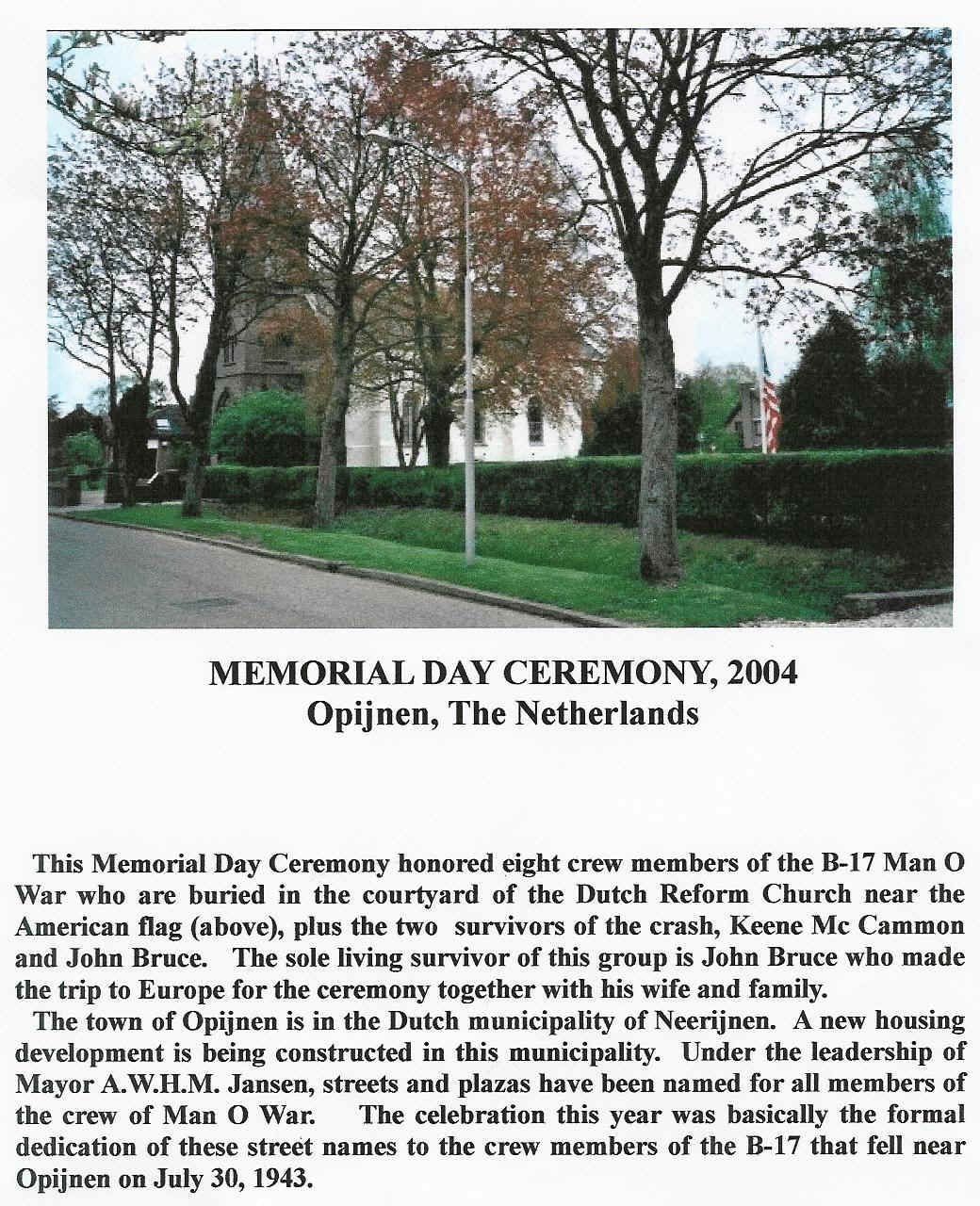
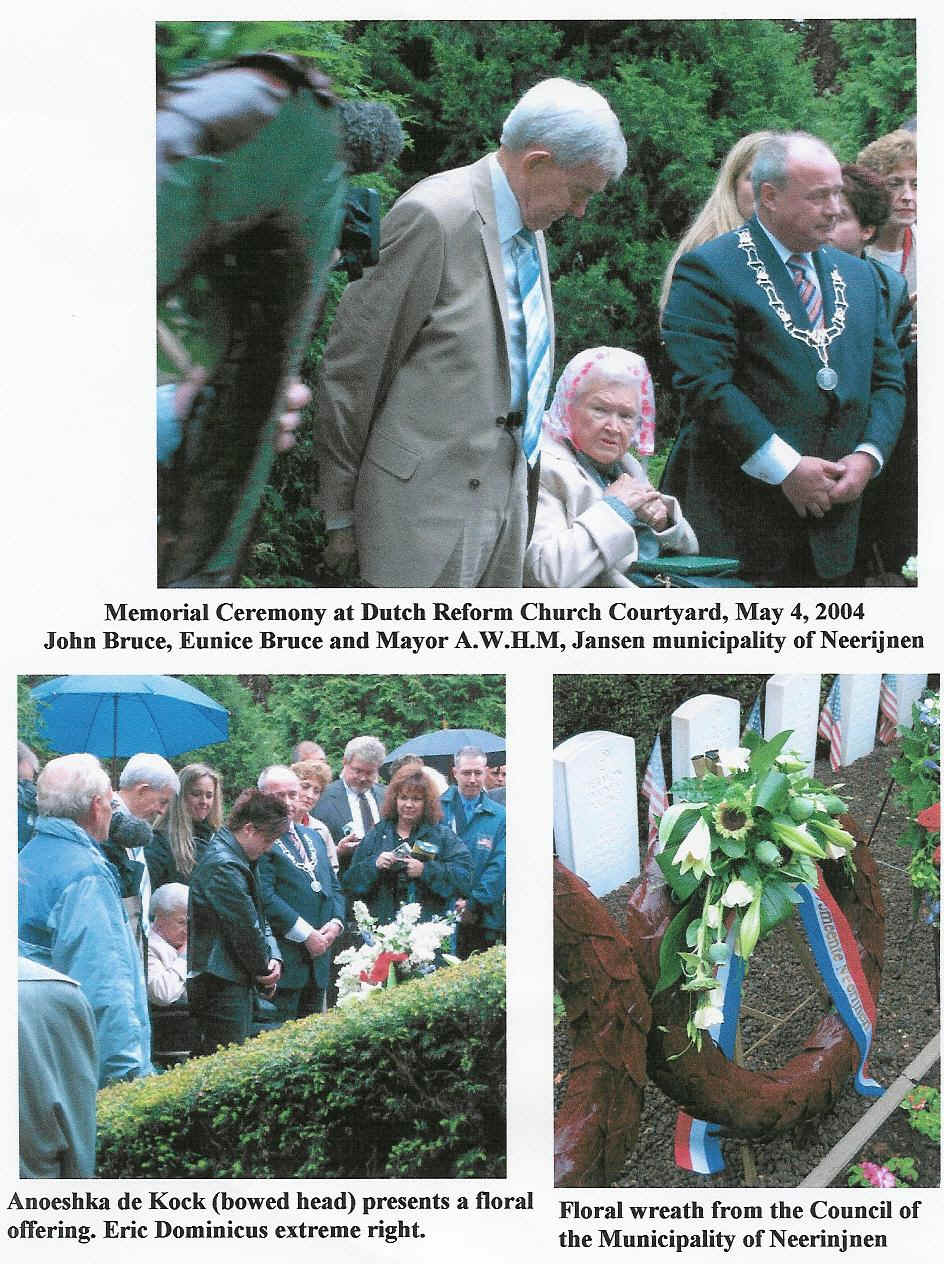
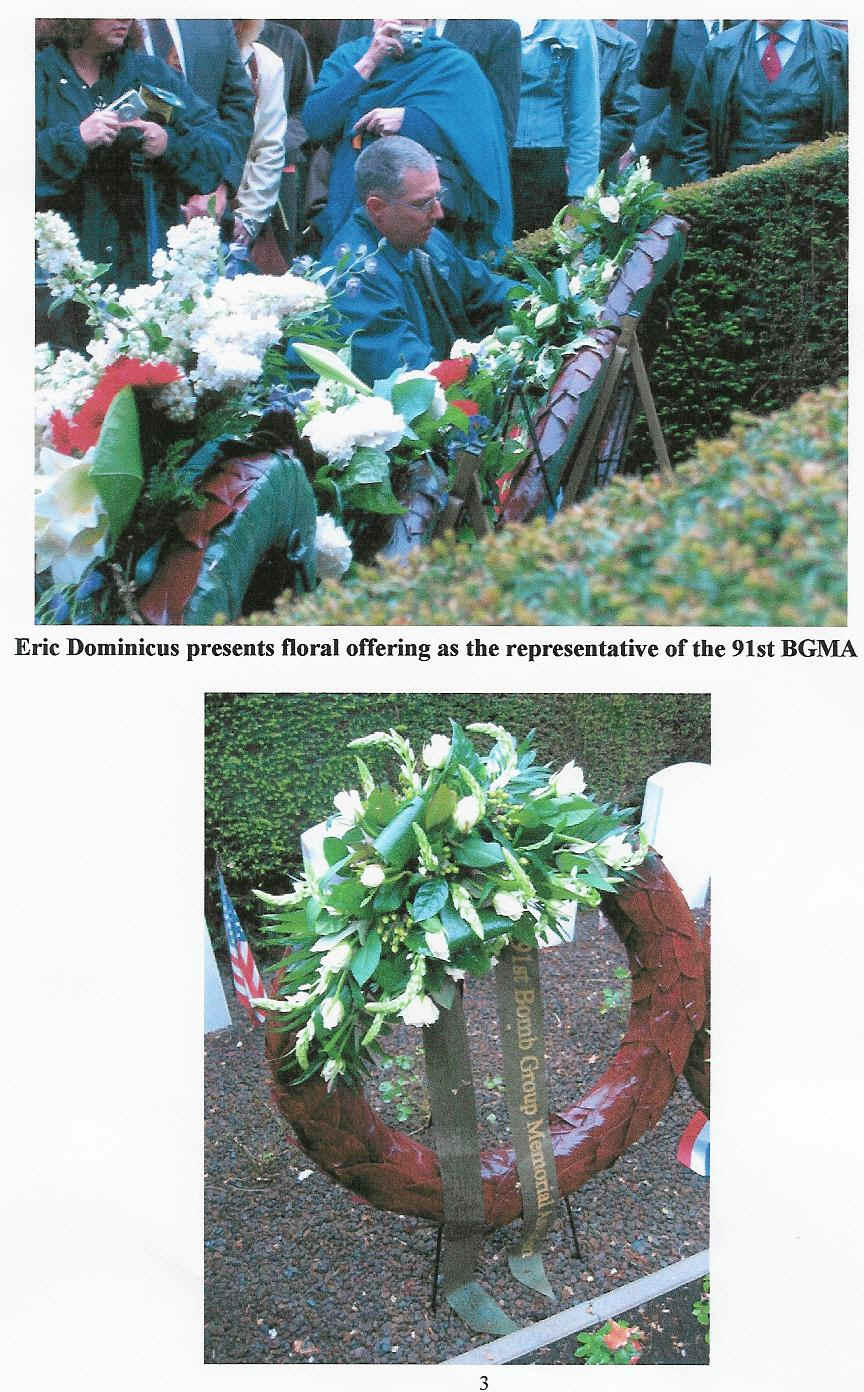
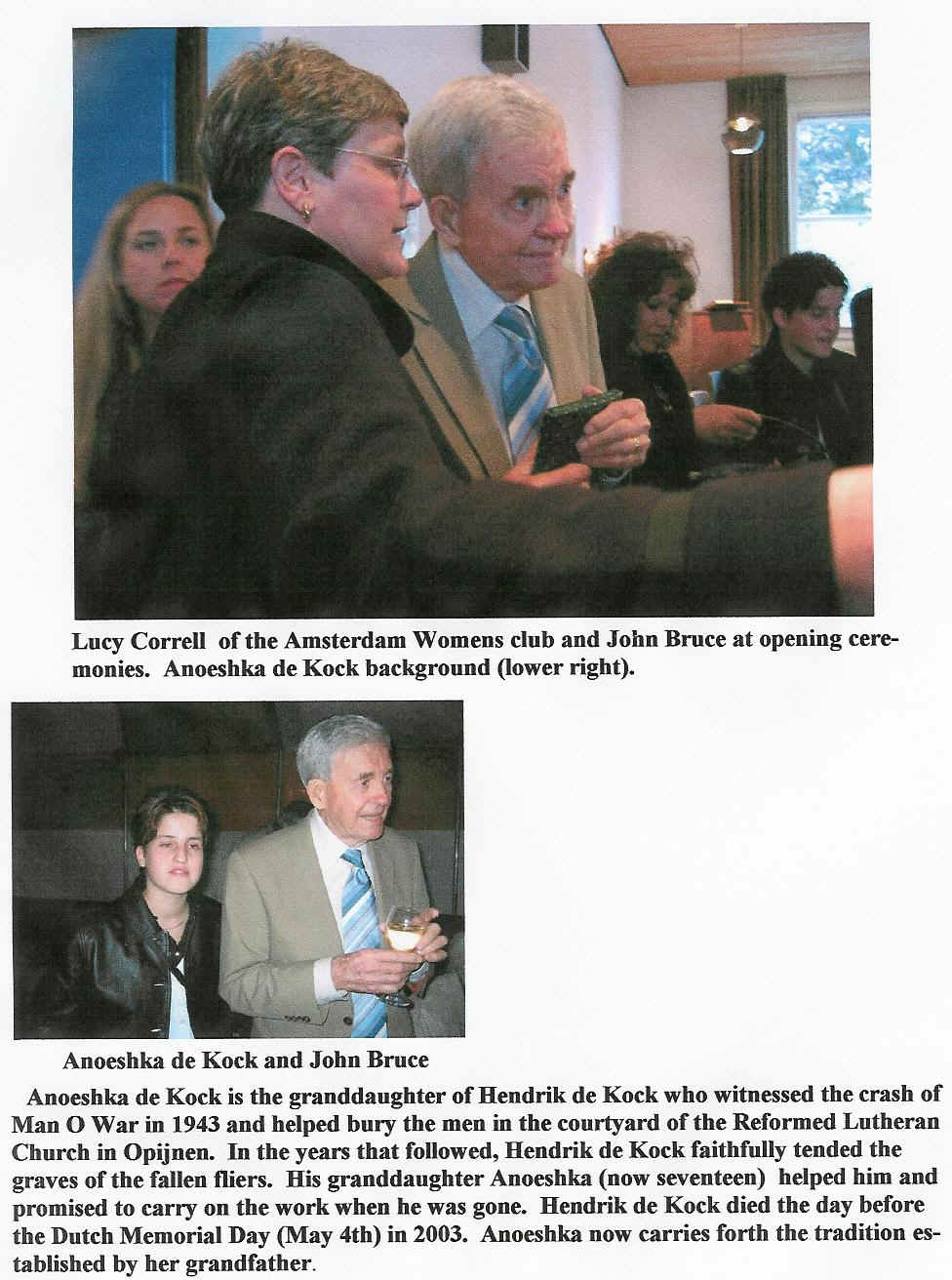
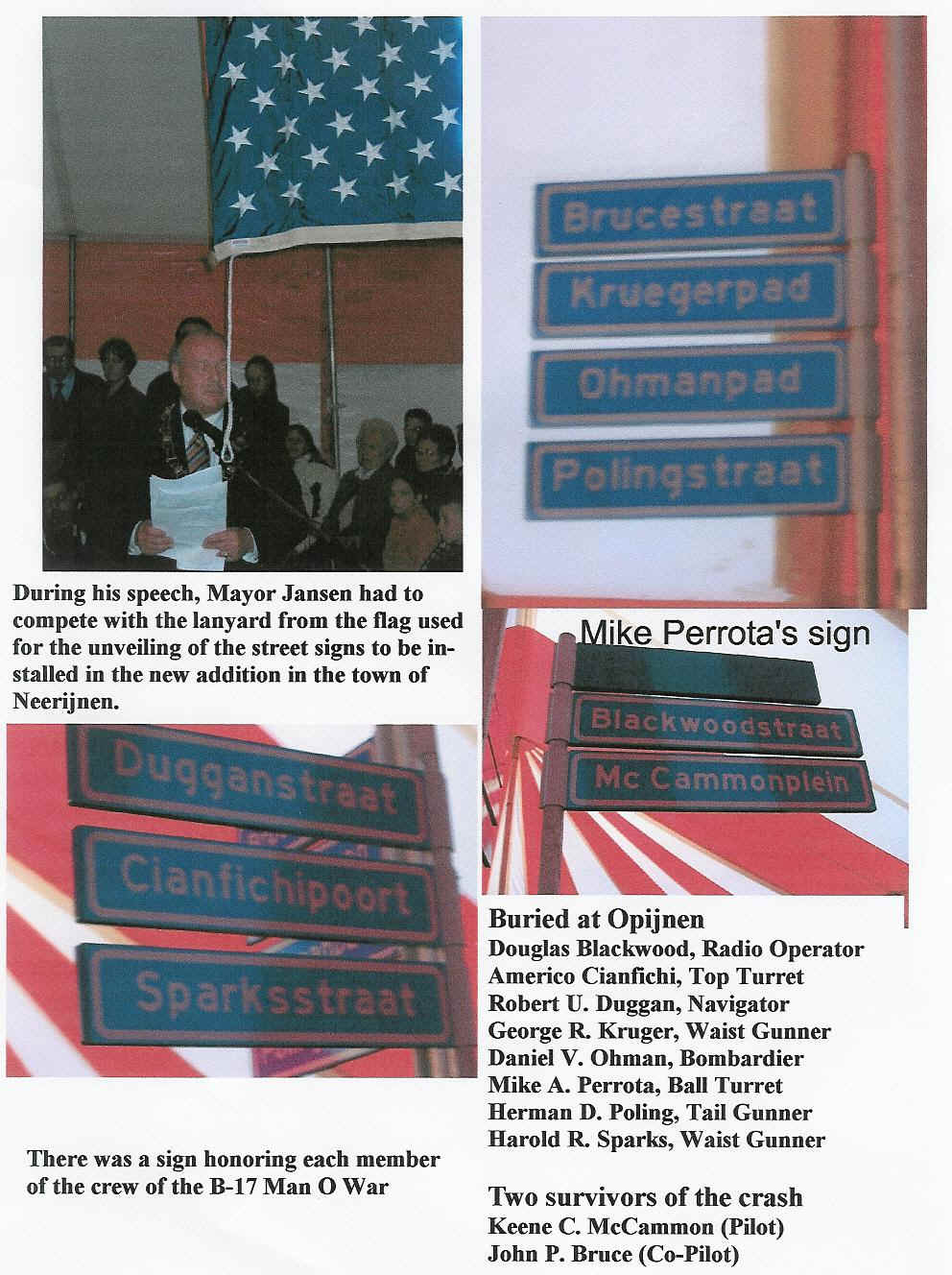
© COPYRIGHT 91STBOMBGROUP.COM